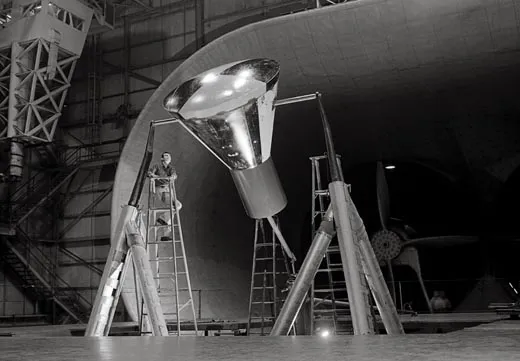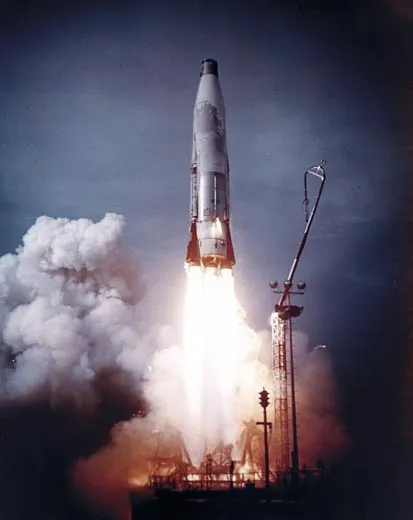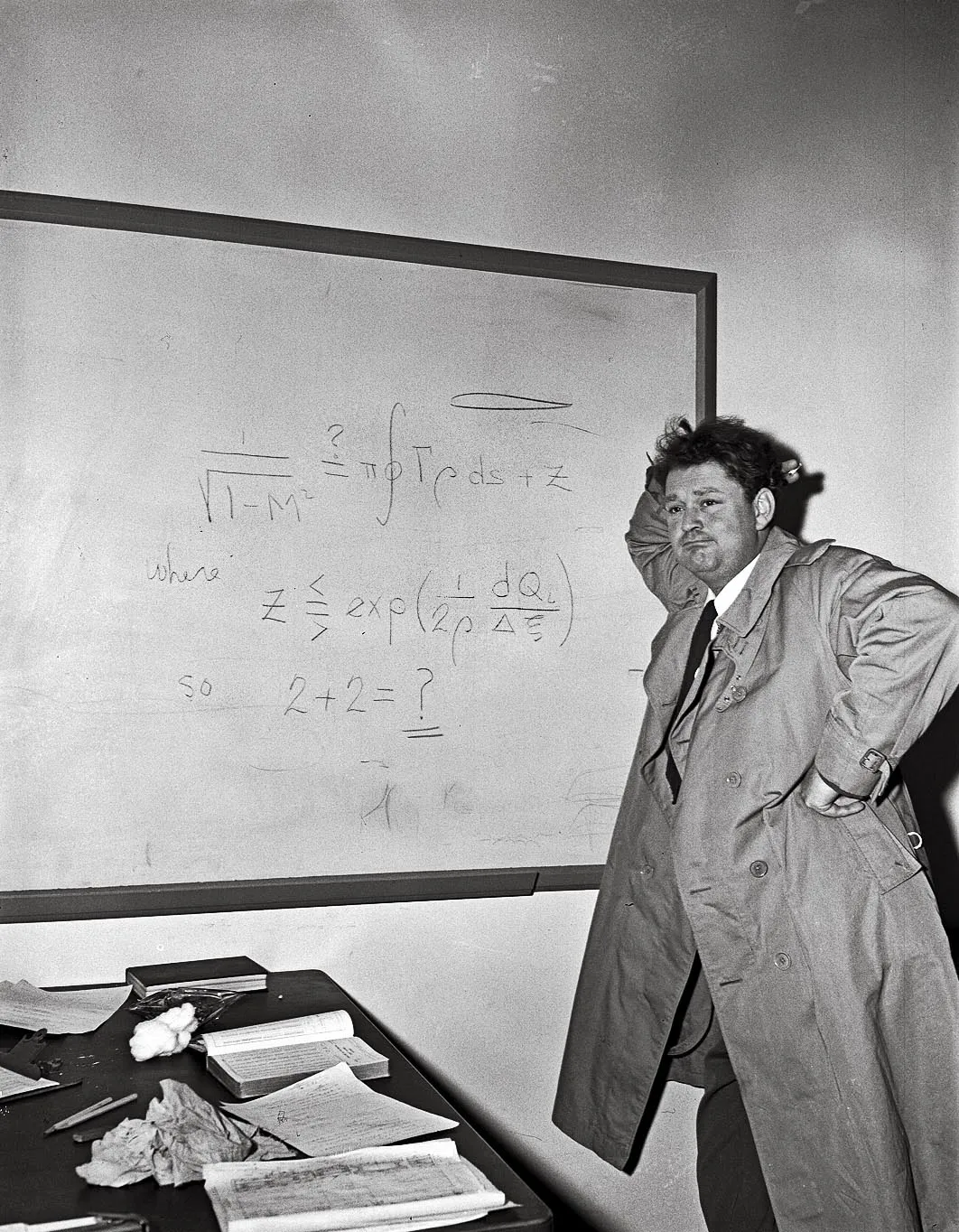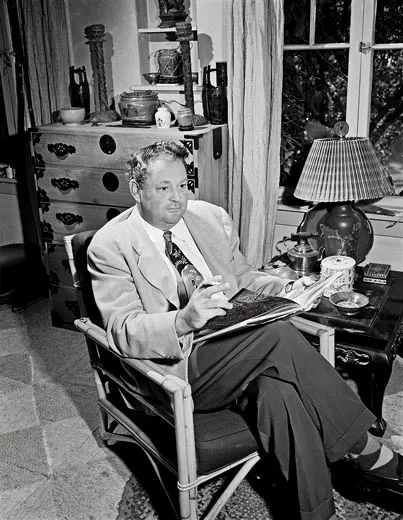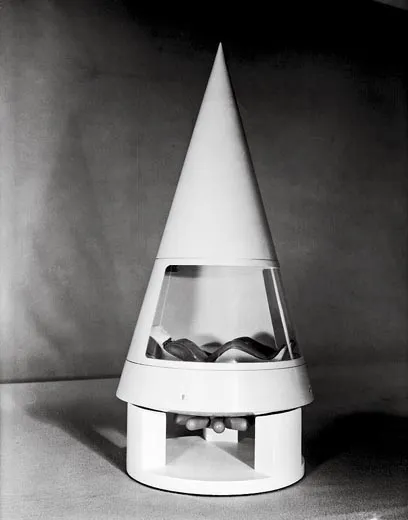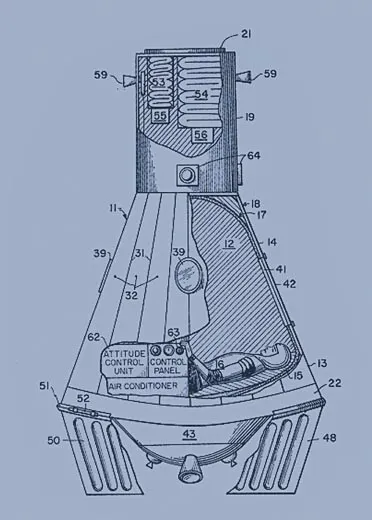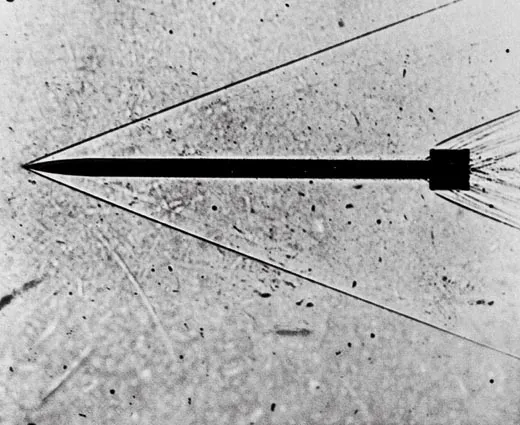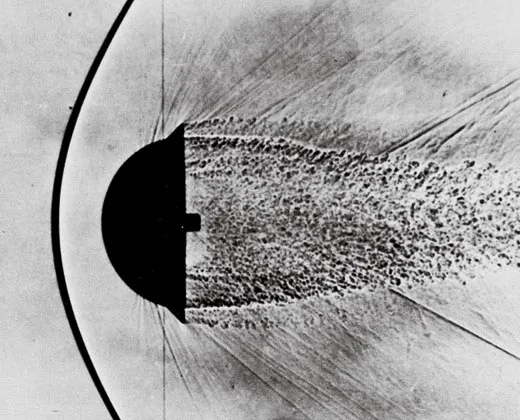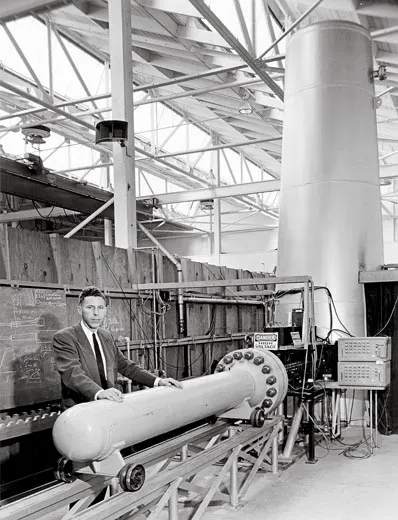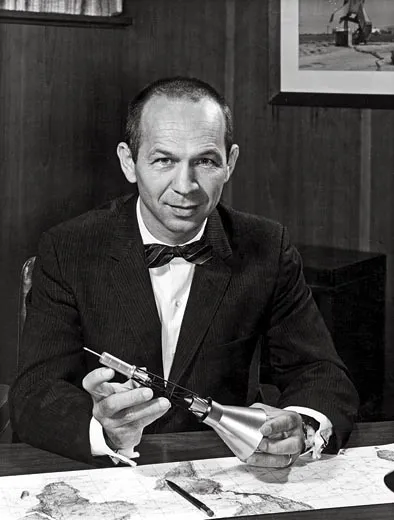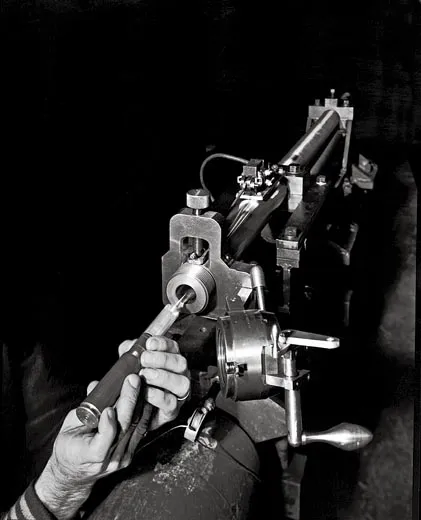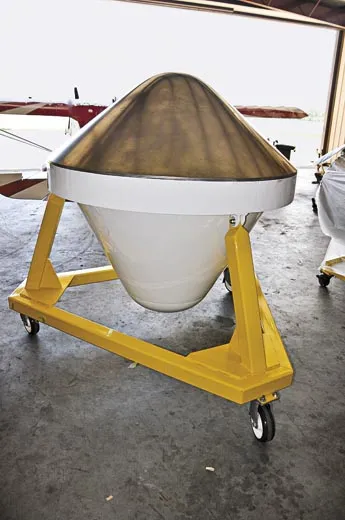How the Spaceship Got Its Shape
In the 1950s Harvey Allen solved the problem of atmospheric entry. But first he had to convince his colleagues.
/https://tf-cmsv2-smithsonianmag-media.s3.amazonaws.com/filer/Space_Shape_Flash_ON09.jpg)
The cover of the March 22, 1952 issue of Collier’s magazine made an audacious promise. “Man Will Conquer Space Soon,” blared the headline, above a painting of a multi-stage rocket with engines blazing, bound for orbit. Designed by German rocket pioneer Wernher von Braun, whose name was still unknown to most Americans, the Collier’s spaceship was a sleek, needle-nosed beauty; its winged third stage would be piloted to a runway landing. But it was all wrong.
When the Soviet Union and the United States flew the first real spaceships just nine years later—far sooner than most experts had predicted in 1952—they were anything but sleek. One was shaped like a bowling ball; the other resembled a Styrofoam coffee cup. They came back to Earth not gliding on wings but dangling from parachutes. What happened during those nine years to change the shape of spaceflight? It had less to do with dreams of conquering Mars than with the infant science of hypersonics, a classified missile program, and a couple of visionary engineers.
In the spring of 1952, even as millions of Collier’s readers marveled at the magazine’s visions of the future, engineers were grappling in secret with the almost insurmountable difficulties of designing the first intercontinental ballistic missiles (ICBMs). Creating a rocket with enough power and accuracy to lob a multi-ton nuclear warhead at targets in the Soviet Union, some 6,000 miles away, was challenging enough. But another problem was just as daunting: how to make sure the warhead survived its high-speed reentry from the edge of space. Slamming into the upper atmosphere at 20 times the speed of sound, the warhead would encounter tremendous friction, creating temperatures of 12,000 degrees Fahrenheit.
A protective nose cone would have to be created; the question was, what kind? To minimize friction, conventional wisdom called for using the same kinds of low-drag shapes—thin, knife-edge wings and sleek, needle-nose bodies—being developed for experimental supersonic aircraft like the Douglas Skyrocket. But when models of needle-nosed shapes were tested in wind tunnels, the results were discouraging: At Mach numbers approaching those expected for a real ICBM reentry, the tips of the nose cones began to melt. Something was wrong with the conventional wisdom, and finding a solution would take an unconventional thinker.
There was such an engineer at the Ames Research Center, a National Advisory Committee for Aeronautics facility near San Francisco where researchers were exploring the boundaries of high-speed flight. He was an ebullient, larger-than-life Californian named H. Julian Allen, known to colleagues as Harvey, a nickname taken from the invisible rabbit in the Broadway play. Talking to him, colleagues sensed his agile mind; in conversation he might jump from aerodynamics to Rachmaninoff (an accomplished pianist, Allen would play a piece and challenge friends to guess the composer). He also loved Asian culture, and on a trip to Cambodia’s Angkor Wat bought so much furniture that he had to add a couple of rooms onto his Palo Alto house to contain it. For his dinner guests, who sometimes numbered in the dozens, Allen would cook exotic meals ranging from Scandinavian dishes to Creole gumbos. One colleague recalls his beef bourguignon as “the best I’ve ever eaten.”
But his true genius was aeronautics. He had helped design the P-51 Mustang, one of World War II’s most successful fighters. Before the first sonic booms echoed over Edwards Air Force Base in the Mojave Desert, Allen was thinking about how to break the sound barrier, and by 1952, as chief of the Ames High-Speed Research Division, he was exploring the field of hypersonics—flight at then-unattained speeds above Mach 5. “Harvey was so broad in his ability to think,” remembers fellow Ames aerodynamicist Jack Boyd. “He was always, it seems to me, about five or six years ahead of everybody else.”
As an advisor on the secret ICBM program, Allen was well aware of the warhead reentry problem, and it was exactly the kind of situation where he thrived. “He was very, very strong in aerodynamics,” says Jim Arnold, an aerodynamicist who came to Ames in 1962. “But he also had the breadth to understand the physics that was going on. A lot of aerodynamicists, you start talking about gas processes and the chemical reactions that go on, they just sort of blink, because they really work in a perfect-gas [idealized] world, where those effects are not important. But he understood what’s going to happen when you start going from, say, Mach 1, which the P-51 was approaching in a dive, to Mach 25. He understood what’s going to happen when those vehicles go fast.”
More than most of his colleagues, Allen was equally at home in the theoretical and the experimental realms. He attacked the reentry problem not with a wind tunnel but with pencil and paper. Having spent several years studying the details of airflow around supersonic jets, he now considered how a reentering warhead would interact with the upper atmosphere. As the warhead slowed down, much of its kinetic energy would be converted into heat. But Allen realized that the very thing that made low-drag shapes an advantage in supersonic flight—a minimum of drag—was a liability in hypersonic flight. The pointed nose generated only a thin shock wave of compressed gas, which provided little protection from the intensely heated air around it; the amount of heat reaching the warhead was far greater than any known material could withstand. The answer, Allen realized, was to slow down the reentry by creating as much drag as possible, which could be accomplished by using a blunt shape. The result would be a thick, free-standing shock wave that would insulate the warhead from most of the heat its deceleration generated.
Allen fostered a spirit of collaboration among his people: He would frequently discuss ideas with colleagues over lunch. When the reentry problem came up around the table on one such occasion in 1951, Allen made the surprising suggestion that the right shape might be something resembling a Civil War cannonball. By the summer of 1952, he and Al Eggers, one of his young engineers, were immersed in a mathematical study of the problem. Their results turned conventional wisdom on its head. “Not only should pointed bodies be avoided,” they wrote in a classified 1953 paper, “but the rounded nose should have as large a radius as possible.”
When Allen and Eggers’ paper was circulated among missile researchers, the findings were met by intense skepticism. But that didn’t faze Allen. “He just thought of it as another hurdle he had to cross,” Boyd recalls, “and it didn’t really bother him very much…which I thought was remarkable. He took what criticism he got and what accolades he got sort of the same way: ‘I’m just doing what I want to do.’ ”
By 1955, after extensive testing in wind tunnels, the Air Force had adopted the blunt-body shape for the nose cone of its Atlas ICBM, which was then in development. But it wasn’t until 1957, when the 1953 paper was declassified, that the world learned of Harvey Allen’s achievement. News coverage hailed Allen’s discovery as a stroke of genius. Hugh Dryden, director of the NACA, “ranked the discovery with the development of a smaller hydrogen bomb,” according to the New York Times. “He said it had lifted the status of the ballistic missile from a practical impossibility to a virtual certainty.”
Allen downplayed his role in the breakthrough, telling one reporter in 1957, “It’s all in the physics book…. All I did was apply known laws.” But his accomplishments still evoke admiration; aviation historian Tom Heppenheimer calls the 1953 treatise “quite probably…the single most important paper ever written in the field of hypersonics.”
In the 1950s, many in the military services were consumed with designs for warheads and missiles, but a small community of engineers was working on human travel outside the atmosphere. In the young field of spaceflight, designers still thought in terms of winged, streamlined vehicles. By the fall of 1957, in a project with the Air Force, a handful of NACA engineers had designed a rocketplane called the X-15, which was designed to reach speeds up to Mach 7 and altitudes of 50 miles or more—the edge of space. Even though the first X-15 flight was two years away, they were already envisioning a more advanced craft, a hypersonic glider that would launch atop an ICBM on a suborbital trajectory. Everyone assumed this would lead in a slow, incremental way to orbital flight, a milestone that piloted vehicles might not reach for a couple of decades.
In mid-October 1957, the engineers working on the X-15’s successor gathered at Ames for the so-called Round Three conference to debate the merits of competing designs for the hypersonic glider. One engineer, a small and wiry man named Max Faget, would make the crucial connection between Harvey Allen’s blunt-body concept and human spaceflight.
Faget (pronounced “fah-JAY”) came from a family of innovators. In the mid-19th century, his great-grandfather, Jean-Charles Faget, helped save New Orleans from a yellow fever epidemic by discovering a telltale change in body temperature and pulse rate that became known as Faget’s Sign. The discovery made it possible for doctors to diagnose victims and isolate them before the disease could spread. In the 1940s, Max’s father, Guy Faget, discovered the first successful treatment for leprosy.
Max, in love with airplanes, chose aeronautical engineering. Singularly confident, he never worried about fitting in. In 1946, he arrived for his first job interview at the NACA’s Langley Research Center in Virginia wearing shorts, sandals, and a Hawaiian shirt. The center hired him anyway, as much for his guts as his brains; Langley director Robert Gilruth, who went on to head NASA’s Manned Spaceflight Center in Houston during the Apollo moon landings, was impressed by Faget’s volunteering for submarine duty in World War II. Although his attire became more conventional later—he was fond of bow ties—Faget never lost his streak of individualism. During meetings he might startle colleagues by leaping over chairs (he’d been a gymnast in college) or doing a headstand—to improve the blood flow to his brain, he said. For all his eccentricities, however, Faget’s approach to engineering was steadfastly practical. NASA legend Chris Kraft, who saw Faget in action from the space program’s earliest days, calls him “as brilliant an engineer as I have ever known, bar none.”
At the time Faget and the others arrived at Ames for the Round Three conference, the Soviet Union had just launched Sputnik. All of them realized it was only a matter of time before the Soviets would follow their achievement with a manned spacecraft. To Faget, slow, incremental progress would no longer do; the most important thing was getting Americans into orbit as soon as possible. He knew that wouldn’t happen with the kinds of designs then being considered for the hypersonic glider; reentry heating would do them in. At Ames, Faget crossed paths with Harvey Allen, who described his blunt-body concept. “I bought it right away,” Faget told me in an interview years later (he died in 2004). Back at Langley, he spent the next several months designing a wingless, blunt-body manned vehicle that would reenter on a ballistic path.
When the Round Three participants reconvened at Ames in March 1958, this time to work out a plan for an orbital vehicle, Faget presented his concept. And like Allen before him, he encountered skepticism. True, the X-15, like its planned successors, would reenter the atmosphere with its nose high, presenting its broad underside to the airflow in what was essentially an application of the blunt-body principle. But it was still an airplane, with its flight path controlled by a pilot. Faget was talking about a wingless body whose occupant seemed more like a passenger. But he was completely convinced.
One of those in attendance was a young NACA test pilot named Neil Armstrong, who remembers Faget’s bluntness as he addressed the gathering. “Max made his pitch,” Armstrong recalls, “saying with substantial emphasis something to the effect that if we wanted to get a man into orbit in a reasonably short period of time with technology that was available to us, the only reasonable option was the wingless blunt body flying a ballistic trajectory. I think Max was frustrated that everyone could not immediately seem to see the logic of his proposal.”
“It was so obvious,” Faget later recalled. “But believe me, this wasn’t an acceptable solution to most of my colleagues. It was anathema. It was a break with the faith…. But it was the right way to do it.” What Faget loved about the design was its simplicity. For the astronaut to return to Earth, only one event—firing the retro-rockets in the right direction to slow down the craft so it could fall out of orbit—need happen. From then on, a broad, gently curving heat shield would face into the direction of flight, slowing the craft until it was in the lower atmosphere, when it would deploy a parachute for landing.
Throughout the spring and summer of 1958, Faget continued to refine the concept for the ballistic craft, which came to be known as “the capsule.” Longtime collaborator Caldwell Johnson refined Faget’s ideas in superb engineering drawings; other colleagues performed wind tunnel tests on candidate shapes. To minimize heating, they found, the heat shield should possess a radius of curvature 1.5 times its diameter. Other tests showed that if the capsule itself were shaped like a truncated cone, it would automatically right itself during reentry, even if the onboard control system failed, an event Faget considered likely. Another concern raised during the Ames conference was that ballistic reentry would be associated with high G-forces. In response, Faget invented a form-fitting “survival couch” to help pilots withstand the crushing deceleration. When volunteers rode the contour couch in a Navy centrifuge, they endured more than 20 Gs. Faget knew the problem had been solved.
Ultimately, one characteristic of the ballistic vehicle clinched its selection: It was lightweight enough to be launched by the Atlas missile, whose payload capacity was 2,000 pounds. (The orbital version of the X-15 would have required a launcher more powerful than anything in existence.) By the end of 1958, NACA had become NASA, and Faget’s capsule had been chosen for the agency’s new effort, now christened Project Mercury.
The Mercury spacecraft went on to put the first Americans in orbit—but not before Soviet cosmonaut Yuri Gagarin, riding in a craft called Vostok, got there first. Taking advantage of the greater payload capacity of their R7 booster, the Soviets gave Vostok a spherical shape, like Harvey Allen’s cannonball, so there was even less worry about controlling its orientation during reentry. But Faget’s gently curved heat shield showed up in the next-generation Soviet spacecraft, called Soyuz—just as it did in Gemini and Apollo. Even the space shuttle, the first winged spacecraft, reentered in the nose-high attitude of the X-15, using a modified blunt-body approach along with advanced insulating tiles to save its skin from the heat of reentry. And today, as the shuttle era draws to a close, NASA’s newest manned vehicle, Orion, is back to the “capsule” shape—proving once again that when it comes to spaceflight, blunt is beautiful.
Andrew Chaikin’s latest book is Voices From the Moon: Apollo Astronauts Describe Their Lunar Experiences (Studio, 2009).
